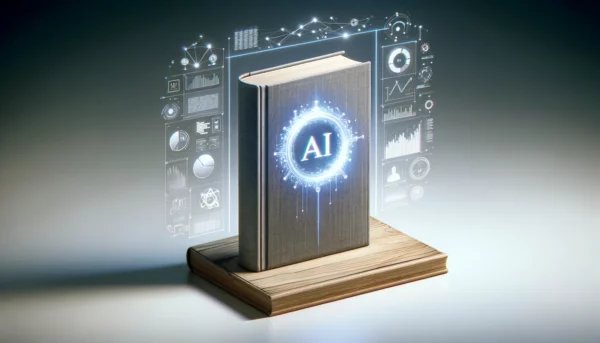In an ever-evolving and competitive publishing landscape, the ability to optimize book sales is crucial for publishers, authors, and sales and marketing teams alike. In fact, maximizing the reach and profitability of books while minimizing risks is a fundamental goal in the industry.
With the advent of artificial intelligence (AI), the publishing industry has witnessed a transformative shift. AI sales assistant tools have emerged as powerful allies in the quest for optimizing book sales. AI sales tools offer publishers and authors data-driven insights, automation capabilities, and a competitive edge.
This article aims to provide a comprehensive understanding of AI sales software tools and how AI sales assistant tools can help your sales team optimize the book sales process. We will explore the various types of AI Tools for Book Sales Optimization that are revolutionizing the publishing industry, such as predictive analytics, recommendation engines, sentiment analysis, and customer segmentation.
Additionally, we will discuss the various sales software tools and the numerous benefits that come with the adoption of these tools. Through this exploration, readers will gain valuable insights into strategies for success in the world of book sales.
What’s the use of AI Tools for Book Sales Optimization?
AI sales tools have a range of applications in helping sales teams optimize the sale of books. These sales assistant tools encompass a range of software and technologies that leverage artificial intelligence and machine learning to enhance various aspects of the publishing industry.
These tools are designed to assist publishers, authors, and sales teams in making data-driven decisions, improving marketing strategies, and ultimately increasing book sales.
Your Publishing Journey Awaits – Start NowTypes of Artificial Intelligence Tools in Publishing
In the rapidly evolving world of publishing, the adoption of artificial intelligence (AI) tools has become a game-changer, redefining the way books are created, marketed, and distributed.
Among the various AI applications that have gained prominence in the industry, predictive analytics stands as a formidable force. This section explores predictive analytics as one of the key types of tools transforming the publishing landscape.
Predictive Analytics
Predictive analytics of AI-powered tools utilize historical sales data, market trends, and other variables to forecast future book sales. By identifying patterns and correlations, these tools help publishers and authors make informed decisions regarding book production, marketing campaigns, and distribution strategies.
Recommendation Engines
Recommendation engines powered by AI analyze reader preferences, behavior, and browsing history to provide personalized book recommendations. These tools are commonly used on e-commerce platforms and book retailers’ websites to enhance user experience and boost book discoverability.
Sentiment Analysis
Sentiment analysis AI-driven tools examine customer reviews, social media mentions, and online discussions to gauge public sentiment toward books and authors. Publishers can use this data to assess the reception of their titles and make improvements or adjustments as needed.
Customer Segmentation
Artificial intelligence tools categorize readers into distinct groups based on their demographics, reading habits, and preferences. This segmentation enables publishers to tailor marketing campaigns, content, and book recommendations to specific target audiences, resulting in more effective sales strategies.

Benefits of Utilizing AI Sales Tools
The integration of AI sales tools in the publishing industry offers a myriad of advantages, revolutionizing the way books are created, marketed, and distributed.
In an era defined by rapidly changing reader preferences, competitive markets, and an ever-expanding array of publishing options, AI sales tools emerge as invaluable allies in navigating these complexities. Let’s explore the diverse benefits they bring to publishers, authors, and booksellers alike.
Your Publishing Journey Awaits – Start NowEnhanced Decision-Making
Artificial intelligence technology can provide publishers and authors with data-driven insights, helping them make informed decisions on book production, marketing budget allocation, and distribution strategies.
Improved Book Discoverability
Recommendation engines increase the visibility of books by suggesting titles to readers who are likely to be interested, thereby expanding a book’s potential audience.
Real-time Market Insights
AI-powered tools continuously monitor market trends, enabling publishers to adapt quickly to changing reader preferences and competitive landscapes.
Cost Efficiency
AI-driven automation can streamline various publishing and sales processes further, reducing operational costs and optimizing resource allocation.
Increased Sales and Revenue
By utilizing AI sales tools effectively, publishers and authors can make sales reps ultimately drive higher book sales and revenue, ensuring the sustainability of their ventures in the ever-evolving world of publishing.
The Sales Process in Book Publishing
The book sales process in the publishing industry involves a series of interconnected stages and activities aimed at bringing a book from its creation to the hands of readers. It is a multifaceted journey that requires careful planning and execution to maximize sales and reader engagement.
Key Stages in Book Sales
The book sales process in the publishing industry is a multi-faceted journey that involves a series of interconnected stages, each crucial to the success of a book.
Understanding these key stages of the sales pipeline is essential for publishers, authors, and booksellers looking to optimize sales and engage with their audience effectively.
In this section, we will take a closer look at the various stages that make up the book sales process, shedding light on their significance and the strategies employed to excel at each one.
Whether you are a seasoned industry professional or a newcomer to the world of publishing, this exploration will provide valuable insights into the intricate workings of book and sales operations in the modern era.
Acquisition
The acquisition stage marks the beginning of the book and sales cycle process. Publishers or authors decide which titles to publish, whether they are acquiring manuscripts from authors or commissioning works. Key considerations include market potential, target audience, and the book’s fit within the publisher’s catalog.
Promotion
Promotion is a crucial phase where books are marketed to create awareness and generate interest. This stage involves crafting marketing strategies, designing promotional materials, and leveraging various channels such as social media, email marketing, and advertising to reach potential readers.
Distribution
Distribution encompasses the logistics of getting books into the hands of retailers, wholesalers, and ultimately, readers. This involves decisions about printing, warehousing, shipping, and digital distribution methods. An efficient distribution strategy ensures that books are readily available to meet demand.
Customer Engagement
Customer engagement is an ongoing process that involves building and maintaining relationships with readers. Publishers and authors interact with readers through book signings, author events, social media engagement, and online communities. Building a loyal reader base is essential for long-term success.
Challenges in the Traditional Sales Process
While the traditional book sales process has its merits, it also presents several challenges:
- Market Uncertainty: Predicting reader preferences and market trends can be challenging, leading to uncertainty in acquisition decisions.
- Marketing Costs: Effective promotion often requires substantial marketing budgets, which may not always be feasible for smaller publishers or independent authors.
- Inventory Management: Inefficient inventory management can result in overstock or understock situations, impacting revenue and profitability.
- Competition: The publishing industry is highly competitive, making it difficult for new titles to gain visibility and market share.
- Changing Consumer Behavior: Evolving consumer preferences, such as the shift to digital reading, require publishers to adapt their strategies to stay relevant.
In light of these challenges, the integration of AI-powered tools in the book sales process can help publishers and authors navigate the complexities of the industry more effectively, as explored in subsequent sections of this article.
Leveraging Artificial Intelligence Tools in the Acquisition Phase
In the dynamic and ever-evolving landscape of book publishing, the process of acquiring manuscripts or deciding which titles to develop is a pivotal starting point on the journey to successful book sales.
The acquisition phase is where publishers and authors make critical decisions that can significantly impact a book’s performance in the market.
As we explore the integration of artificial intelligence into the acquisition phase, we will uncover how AI is reshaping the way publishers and authors identify potential titles, analyze market trends, assess competitors, and predict bestsellers.
These AI-driven insights are revolutionizing decision-making processes and enabling stakeholders to make more informed choices, ultimately leading to a more efficient and profitable acquisition strategy.
Whether you are a publisher seeking to expand your catalog or an author looking to make data-driven decisions about your next manuscript, this section will illuminate the transformative power of AI-powered tools in the acquisition phase of book publishing.
It’s a journey that promises to unlock new possibilities and opportunities in a rapidly evolving industry.
Identifying Potential Titles
In the dynamic world of publishing, identifying potential titles that will resonate with readers is a critical first step. AI-powered tools excel in this regard by analyzing vast amounts of data, including historical sales data, reader preferences, and emerging trends.
These tools can help publishers and authors make informed decisions about which manuscripts to acquire or develop.
By assessing factors such as genre popularity, niche markets, and audience demographics, AI-driven insights can guide the selection of titles with a higher likelihood of success.
Your Publishing Journey Awaits – Start NowAnalyzing Market Trends
Keeping up with ever-changing market trends is essential for staying competitive. Artificial intelligence technology can monitor and analyze market trends in real time, providing publishers and authors with valuable insights.
Whether it’s tracking the popularity of specific genres, identifying emerging subgenres, or recognizing shifts in reader preferences, AI-driven market trend analysis enables stakeholders to adapt their acquisition strategies and align their titles with current market demands.
Competitor Analysis
Understanding the competitive landscape is vital for success in publishing. AI can assist in competitor analysis by collecting and analyzing data on competing titles, their sales performance, marketing strategies, and reader reviews.
This information allows publishers and authors to identify gaps in the market, fine-tune their offerings, and develop competitive advantages. By leveraging AI-powered insights, stakeholders can make data-driven decisions to position their titles effectively.
Predicting Bestsellers
Predicting which books will become bestsellers is a challenging but essential task in the acquisition phase. AI technology equipped with predictive analytics capabilities can analyze historical data, author profiles, book content, and early reader engagement to forecast the potential success of a title.
These tools generate predictive models that estimate sales volumes and help publishers and authors allocate resources more effectively. While predictions are not infallible, they provide valuable guidance for prioritizing and investing in titles with a higher probability of becoming bestsellers.
Incorporating AI-powered tools into the acquisition phase not only streamlines decision-making processes but also increases the likelihood of acquiring and developing books that align with market dynamics and reader preferences.
This data-driven approach enhances the overall efficiency and effectiveness of the book acquisition process in the publishing industry.
Streamlining Distribution with AI
Efficient distribution is the lifeblood of the publishing industry, ensuring that books reach readers when and where they want them. It’s a complex web of logistics, inventory management, and supply chain optimization that can make or break a book’s success.
In this section, we embark on a journey to explore how artificial intelligence (AI) tools are revolutionizing the distribution phase of book publishing.
As we delve into the ways AI is transforming distribution, we’ll uncover how these tools optimize inventory management, forecast demand, enhance supply chain operations, and refine pricing strategies.
AI’s data-driven capabilities enable publishers and booksellers to operate more efficiently, reduce costs, and deliver a seamless reading experience to customers.
Whether you are a traditional publisher, an e-commerce platform, or an independent author, the insights presented here will demonstrate how AI-powered distribution strategies are reshaping the industry, making it more competitive and responsive to the needs of modern readers.
In the pages ahead, you’ll discover how AI is streamlining the flow of books from production to readers’ hands, ensuring that the right books are available at the right time, all while driving operational efficiency and profitability.
Inventory Management
Efficient inventory management is a critical component of successful book distribution. AI-driven tools play a significant role in optimizing inventory levels by continuously analyzing historical sales data, demand patterns, and external factors like seasonality or events.
With real-time insights, publishers and distributors can minimize overstock and understock situations, reducing carrying costs and maximizing revenue.
Demand Forecasting
Predicting future demand for books is a complex task, especially in a constantly evolving market. AI-driven demand forecasting tools use advanced algorithms to consider a multitude of variables, such as historical sales, market trends, promotional activities, and even external factors like weather events or cultural phenomena. By providing accurate demand forecasts, publishers can align their inventory levels and distribution strategies with expected reader preferences.
Supply Chain Optimization
AI technology facilitates supply chain optimization by streamlining the logistics of book distribution. These tools help in route planning, warehouse management, and transportation optimization.
By analyzing various parameters, including delivery times, transportation costs, and inventory levels at different locations, AI assists in achieving cost-effective and efficient supply chain operations. This results in faster delivery times and lower distribution costs.
Pricing Strategies
Setting the right price for books is a delicate balance that can significantly impact sales and profitability. AI-powered tools enable dynamic pricing strategies that take into account factors such as demand, competitor pricing, and historical sales data.
By continuously adjusting prices in real-time, publishers and booksellers can maximize revenue and stay competitive in a market where prices fluctuate rapidly.
Streamlining distribution with AI not only improves the operational efficiency of the publishing industry but also enhances the overall customer experience. Timely deliveries, optimal inventory levels, and competitive pricing contribute to customer satisfaction and loyalty.
As the publishing landscape continues to evolve, AI-powered distribution strategies are becoming indispensable for staying competitive and meeting reader expectations.
Enhancing Customer Engagement
In the ever-evolving world of book publishing, engaging with readers is not merely a goal but a necessity for success.
Reader engagement goes beyond just selling books; it involves creating meaningful connections with your audience, understanding their preferences, and providing them with an experience that keeps them coming back for more.
In this section, we delve into the role of artificial intelligence (AI) in enhancing customer engagement within the publishing industry.
AI-powered tools are at the forefront of transforming the way publishers, authors, and booksellers engage with their readers. Through sentiment analysis, customized experiences, feedback loops, and loyalty programs, AI-powered strategies are reshaping the way books are marketed, recommended, and experienced.
These approaches are not only driving sales but also fostering lasting relationships between content creators and their audiences.
Whether you are a traditional publisher, an independent author, or an e-commerce platform, this section will illuminate the ways in which AI-powered tools are redefining customer engagement.
From understanding reader sentiment to tailoring content recommendations and implementing loyalty programs, AI is the catalyst for creating deeper and more enduring connections with your readers in today’s competitive publishing landscape.
Your Publishing Journey Awaits – Start NowSentiment Analysis in Book Reviews
Understanding how readers perceive and react to books is crucial for improving customer engagement. Sentiment analysis AI-powered tools scan and analyze book reviews, social media mentions, and online discussions to gauge reader sentiment.
By identifying trends in reader opinions, publishers and authors can gain valuable insights into what resonates with their audience and make data-driven decisions to enhance future titles.
Customized Customer Experiences
Personalization is a key driver of customer engagement. AI-powered tools empower publishers and booksellers to create customized customer experiences.
By analyzing customer data, reading preferences, and browsing behavior, these tools can recommend books tailored to individual tastes.
Additionally, AI-driven content recommendations and targeted marketing campaigns enhance the overall reader experience, increasing the likelihood of continued engagement and purchases.
Feedback Loops and Continuous Improvement
Feedback loops powered by AI-powered tools facilitate ongoing improvement in both book content and the customer experience.
By collecting and analyzing customer feedback, publishers can identify areas for enhancement, such as plot development, writing style, or cover design.
This iterative process ensures that future titles align more closely with reader expectations and preferences.
Loyalty Programs
Implementing loyalty programs is an effective strategy to foster long-term customer engagement. AI-driven tools can help in designing and managing loyalty programs by tracking customer behavior, purchase history, and engagement levels. Publishers and booksellers can use this data to reward loyal customers with exclusive content, discounts, or early access to new releases, fostering a sense of belonging and incentivizing repeat purchases.
Final words
Enhancing customer engagement through AI-driven strategies not only helps sales teams to boosts sales but also strengthens the publisher-reader relationship. By using customer interactions, actively listening to reader feedback, providing tailored recommendations, and rewarding loyalty, publishers can cultivate a dedicated and satisfied customer base that is more likely to advocate for their books and remain engaged with their brand.
In the rapidly evolving world of book publishing, the integration of artificial intelligence (AI) tools has emerged as a transformative force, shaping the industry’s landscape from acquisition to distribution and reader engagement. The journey through the various facets of AI’s impact on book sales optimization reveals a remarkable transformation in the way publishers, authors, and booksellers operate and succeed in this dynamic environment.
From understanding the importance of book sales optimization to leveraging AI-powered tools in each critical phase of the publishing process, we have witnessed how data-driven insights, personalization, and automation are becoming key drivers of success. AI’s ability to predict trends, recommend books, streamline distribution, and enhance customer engagement has enabled the industry to adapt, compete, and thrive in the face of ever-changing reader preferences and market dynamics.
As we conclude this exploration, it is evident that AI is not just a tool but a strategic partner in modern publishing. Publishers and authors armed with AI insights can make more informed decisions, optimize their resources, and forge deeper connections with their readers. In an industry that continues to evolve and redefine itself, AI offers the means to remain not only relevant but also at the forefront of innovation.
The future of book sales optimization lies in the continued integration of AI-driven tools, the exploration of emerging technologies, and the commitment to meeting evolving reader expectations. As we embark on this exciting journey, one thing remains certain: AI will continue to be an invaluable asset in shaping the future of the publishing industry, ensuring that stories and knowledge continue to find their way into the hands of readers around the world.








